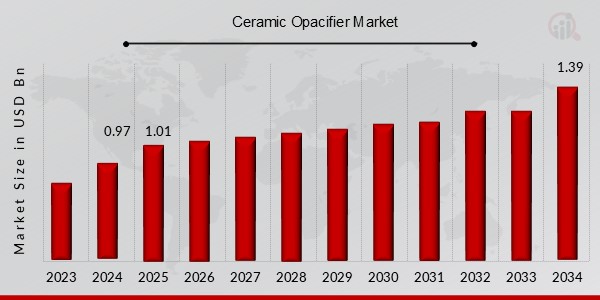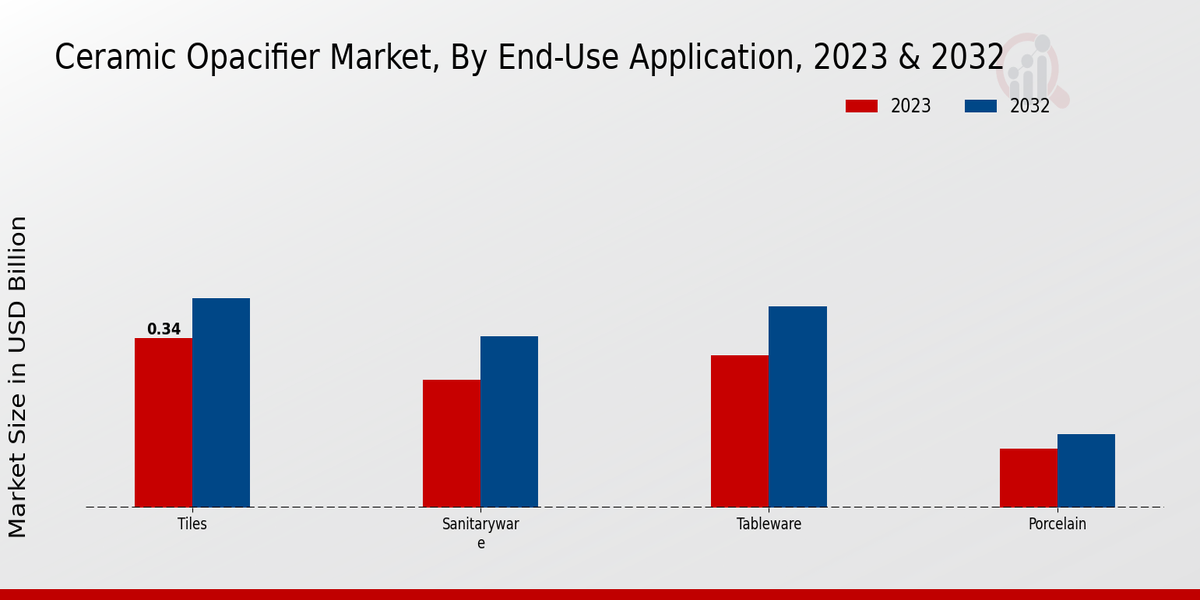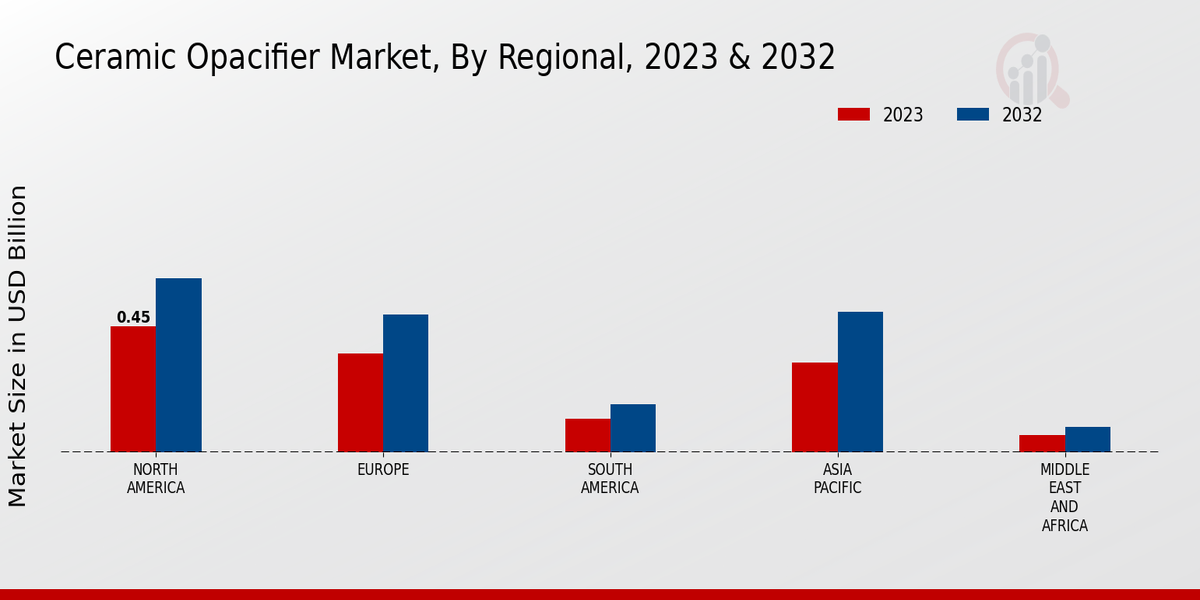Global Ceramic Opacifier Market Overview
The Ceramic Opacifier Market Size was estimated at 0.97 (USD Billion) in 2024. The Ceramic Opacifier Industry is expected to grow from 1.01 (USD Billion) in 2025 to 1.39 (USD Billion) by 2034. The Ceramic Opacifier Market CAGR (growth rate) is expected to be around 3.69% during the forecast period (2025 - 2034).
Key Ceramic Opacifier Market Trends Highlighted
The ceramic opacifier market is witnessing significant growth due to the increasing demand for ceramic tiles and sanitaryware. Ceramic opacifiers are used to enhance the whiteness and opacity of ceramic products, making them more aesthetically pleasing. The growing popularity of large-format ceramic tiles further drives market expansion, as these tiles require high-quality opacifiers to achieve optimal whiteness.Technological advancements are also shaping the market landscape. The development of nano-sized opacifiers has improved the dispersion and efficiency of these additives, leading to enhanced opacity and brightness in ceramic products. The market is also witnessing a trend towards eco-friendly opacifiers, driven by increasing environmental concerns and regulatory initiatives.Opportunities for growth in the ceramic opacifier market lie in emerging economies, where urbanization and rising disposable incomes are fueling the demand for ceramic tiles and sanitaryware. Additionally, the adoption of ceramic opacifiers in non-traditional applications, such as plastics and paints, presents promising avenues for market expansion.
 Source: Primary Research, Secondary Research, MRFR Database and Analyst Review
Ceramic Opacifier Market Drivers
Rising Demand for Ceramics in Various Industries
Source: Primary Research, Secondary Research, MRFR Database and Analyst Review
Ceramic Opacifier Market Drivers
Rising Demand for Ceramics in Various Industries
The increasing use of ceramics in various industries, such as construction, automotive, and electronics, is a major driver of the ceramic opacifier market. Ceramics are known for their durability, strength, and resistance to heat and chemicals, making them ideal for a wide range of applications. In the construction industry, ceramics are used in tiles, bricks, and sanitary ware. In the automotive industry, ceramics are used in spark plugs, brake pads, and exhaust systems.In the electronics industry, ceramics are used in capacitors, resistors, and insulators. The growing demand for ceramics in these industries is expected to continue to drive the growth of the ceramic opacifier market in the coming years.
Increasing Adoption of Digital Printing Technology
The increasing adoption of digital printing technology in the ceramic industry is another major driver of the ceramic opacifier market. Digital printing technology allows for the printing of complex designs and patterns on ceramic surfaces with high precision and accuracy. This technology has enabled manufacturers to produce more innovative and visually appealing ceramic products, which has led to increased demand for ceramic opacifiers. Ceramic opacifiers are used to enhance the brightness and whiteness of ceramic surfaces, making them more suitable for digital printing.The growing adoption of digital printing technology is expected to continue to drive the growth of the ceramic opacifier market in the coming years.
Growing Environmental Concerns
Growing environmental concerns are also driving the growth of the ceramic opacifier market. Traditional ceramic opacifiers, such as lead and cadmium, have been found to have harmful effects on the environment and human health. As a result, there is a growing demand for environmentally friendly ceramic opacifiers. Zirconia and alumina are two examples of environmentally friendly ceramic opacifiers that are gaining popularity in the market. The growing demand for environmentally friendly ceramic opacifiers is expected to continue to drive the growth of the ceramic opacifier market in the coming years.
Ceramic Opacifier Market Segment Insights
Ceramic Opacifier Market End-Use Application Insights
The End-Use Application segment plays a pivotal role in shaping the Ceramic Opacifier Market landscape. In 2023, the Tiles segment held a dominant share of around 38.4%, showcasing its significance in the industry. This dominance is attributed to the widespread use of ceramic tiles in residential, commercial, and industrial settings due to their durability, aesthetic appeal, and ease of maintenance. The Sanitaryware segment is projected to exhibit a robust growth rate during the forecast period, reaching a market value of approximately USD 261.5 million by 2032.This growth is fueled by rising demand for high-quality and visually appealing bathroom fixtures, such as sinks, toilets, and bathtubs, driven by increasing disposable income and urbanization. Tableware, another significant segment, is anticipated to witness steady growth, driven by the growing popularity of ceramic dinnerware and cookware due to their non-porous nature, which makes them hygienic and safe for food contact. The Porcelain segment, renowned for its delicate and translucent properties, is expected to maintain a niche market share due to its premium pricing and specialized applications in high-end tableware and decorative items.Other End-Use Applications, such as insulators, abrasives, and pigments, collectively contribute to the Ceramic Opacifier Market's diversity. These applications leverage the unique properties of ceramic opacifiers, such as their ability to enhance whiteness, opacity, and thermal stability in various industrial processes. Overall, the End-Use Application segment provides valuable insights into the diverse applications of ceramic opacifiers across industries. Understanding these segment dynamics enables manufacturers and suppliers to tailor their products and marketing strategies to meet the specific requirements of each application, driving market growth and innovation.
 Source: Primary Research, Secondary Research, MRFR Database and Analyst Review
Ceramic Opacifier Market Product Type Insights
Source: Primary Research, Secondary Research, MRFR Database and Analyst Review
Ceramic Opacifier Market Product Type Insights
Zirconia-Based, Tin-Oxide-Based, Antimony-Based, and Calcium Zirconate-Based are the most popular product types in the Ceramic Opacifier Market. Zirconia-Based Ceramic Opacifiers held the largest Ceramic Opacifier Market share in 2023, and the segment is expected to continue to lead the market throughout the forecast period. This is due to the high refractive index of zirconia, which makes it an effective opacifier. Tin-oxide-based ceramic Opacifiers are the second most popular type of opacifier, and they are often used in applications where a high degree of opacity is required.Antimony-Based Ceramic Opacifiers are less common, but they are still used in some applications due to their low cost. Calcium Zirconate-Based Ceramic Opacifiers are the least common type of opacifier, but they are gaining popularity due to their high thermal stability.
Ceramic Opacifier Market Manufacturing Process Insights
The Ceramic Opacifier Market is segmented based on Manufacturing Process into Dry Mixing, Wet Mixing, and Granulation. Among these segments, Dry Mixing is expected to hold the largest market share in 2023, owing to its cost-effectiveness and ability to produce high-quality ceramic products. Wet Mixing is also gaining popularity due to its ability to produce a more uniform product with better opacity. Granulation is expected to witness steady growth over the forecast period, as it offers advantages such as improved flowability and reduced dust generation.The growth of the market is attributed to the increasing demand for ceramic products in various industries such as construction, automotive, and electronics.
Ceramic Opacifier Market Regional Insights
The regional segmentation of the Ceramic Opacifier Market offers valuable insights into market dynamics across different geographic regions. North America dominated the market in 2023 and is projected to maintain its lead during the forecast period, owing to factors such as growing demand from the construction and automotive industries. Europe is another key market for ceramic opacifiers, driven by stringent environmental regulations and a strong manufacturing base. The APAC region is expected to witness significant growth over the coming years, fueled by rapid urbanization and increasing disposable income.South America and MEA also present growth opportunities for ceramic opacifier manufacturers. The Ceramic Opacifier Market segmentation provides a comprehensive understanding of regional market dynamics, enabling stakeholders to devise targeted strategies and capitalize on growth opportunities.
 Source: Primary Research, Secondary Research, MRFR Database and Analyst Review
Ceramic Opacifier Market Key Players And Competitive Insights
Source: Primary Research, Secondary Research, MRFR Database and Analyst Review
Ceramic Opacifier Market Key Players And Competitive Insights
Major players in Ceramic Opacifier Market are constantly striving to develop new and innovative products to meet the evolving demands of the market. For instance, in 2023, Ferro Corporation introduced a new line of ceramic opacifiers designed to provide improved whiteness and opacity in ceramic applications. Leading Ceramic Opacifier Market players are also focusing on expanding their presence through strategic acquisitions and partnerships. In 2023, Imerys acquired the ceramic opacifier business of Elementis Specialties, strengthening its position in the market. The Ceramic Opacifier Market industry is characterized by intense competition, with manufacturers vying for market share through product innovation, cost optimization, and strategic partnerships. This competitive landscape is expected to drive the Ceramic Opacifier Market development and growth in the coming years.One of the leading Ceramic Opacifier Market players, Ferro Corporation, has a wide portfolio of ceramic opacifiers designed to meet the specific requirements of different applications. The company's products are known for their high whiteness, opacity, and durability. Ferro Corporation has a strong presence, with manufacturing facilities in North America, Europe, and Asia. The company's commitment to research and development has resulted in the introduction of several innovative products, such as its Optimax line of opacifiers, which provide superior whiteness and opacity in ceramic applications.A notable competitor in the Ceramic Opacifier Market is Imerys. The company's opacifiers are widely used in the production of ceramic tiles, dinnerware, and sanitary ware. Imerys has a strong presence, with manufacturing facilities in Europe, North America, and Asia. The company's focus on research and development has led to the development of innovative products, such as its Opacilite line of opacifiers, which offer high whiteness and opacity in ceramic applications. Imery's commitment to sustainability has also contributed to its success in the market, as the company's products are designed to meet environmental regulations.
Key Companies in the Ceramic Opacifier Market Include
- Solvay
- Ferro Corporation
- Omya AG
- CE Minerals
- FS Cur
- Albemarle Corporation
- Quarzwerke Group
- Zijin Mining
- Sibelco
- Elementis
- BASF SE
- Dupont
- Imerys
- Dow
- Matmatch
Ceramic Opacifier Market Industry Developments
Rising demand for ceramics in various end-use industries, such as construction, automotive, and electronics, is driving market growth. Increasing urbanization and infrastructure development are further contributing to the demand for ceramic opacifiers. Additionally, growing awareness about the aesthetic and functional benefits of ceramic opacifiers is expected to fuel market expansion. Key players in the market include BASF, Imerys, and Ferro Corporation, among others. Recent developments include the introduction of eco-friendly and sustainable ceramic opacifiers to cater to environmental concerns.
Ceramic Opacifier Market Segmentation Insights
Ceramic Opacifier Market End-Use Application Outlook
- Tiles
- Sanitaryware
- Tableware
- Porcelain
- Others
Ceramic Opacifier Market Product Type Outlook
- Zirconia-Based
- Tin-Oxide-Based
- Antimony-Based
- Calcium Zirconate-Based
Ceramic Opacifier Market Manufacturing Process Outlook
- Dry Mixing
- Wet Mixing
- Granulation
Ceramic Opacifier Market Regional Outlook
- North America
- Europe
- South America
- Asia Pacific
- Middle East and Africa
| Report Attribute/Metric |
Details |
| Market Size 2024 |
0.97 (USD Billion) |
| Market Size 2025 |
1.01 (USD Billion) |
| Market Size 2034 |
1.39 (USD Billion) |
| Compound Annual Growth Rate (CAGR) |
3.69% (2025 - 2034) |
| Report Coverage |
Revenue Forecast, Competitive Landscape, Growth Factors, and Trends |
| Base Year |
2024 |
| Market Forecast Period |
2025 - 2034 |
| Historical Data |
2020 - 2024 |
| Market Forecast Units |
USD Billion |
| Key Companies Profiled |
Solvay, Ferro Corporation, Omya AG, CE Minerals, FS Cur, Albemarle Corporation, Quarzwerke Group, Zijin Mining, Sibelco, Elementis, BASF SE, Dupont, Imerys, Dow, Matmatch |
| Segments Covered |
End-Use Application, Product Type, Manufacturing Process, Regional |
| Key Market Opportunities |
1. Growing demand for tiles and sanitaryware 2. Expansion in construction sector 3. Increasing use in automotive and electronics industries |
| Key Market Dynamics |
1. Rising demand in the tiles industry 2. Increasing use in sanitaryware applications 3. Growing adoption in automotive applications 4. Technological advancements 5. Favorable government regulations |
| Countries Covered |
North America, Europe, APAC, South America, MEA |
Frequently Asked Questions (FAQ) :
The ceramic opacifier market was projected to reach USD 0.97 billion in 2024.
The ceramic opacifier market is expected to grow at a CAGR of 3.69% from 2025 - 2034.
Asia Pacific is expected to hold the largest share of the ceramic opacifier market in 2024.
The tiles and sanitary ware segment is expected to dominate the ceramic opacifier market in 2024.
Some of the key competitors in the ceramic opacifier market include Imerys, Sibelco, and Quarzwerke.
Key growth drivers of the ceramic opacifier market include rising demand for ceramic tiles and sanitary ware, increasing urbanization, and growing disposable income.
Key challenges facing the ceramic opacifier market include fluctuating raw material prices and intense competition.
Key trends in the ceramic opacifier market include the development of eco-friendly opacifiers and the growing adoption of digital printing technologies.
The ceramic opacifier market is expected to reach USD 1.39 billion by 2034.
Key opportunities for growth in the ceramic opacifier market include the expansion of the construction industry in emerging economies and the growing demand for high-performance ceramic products.
















